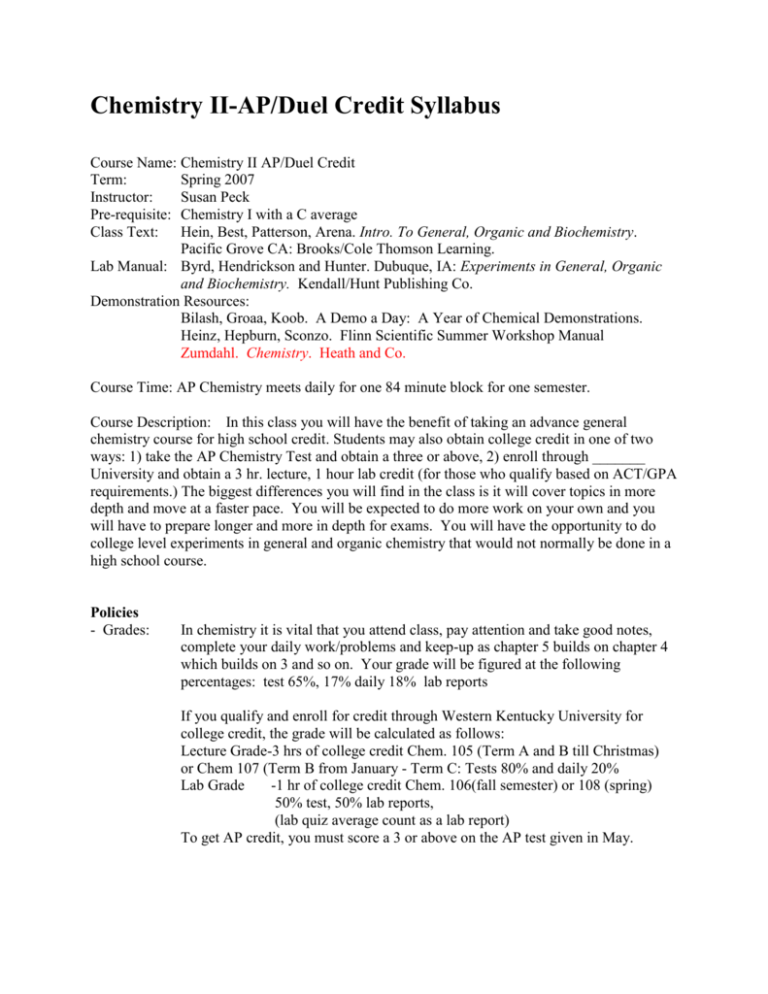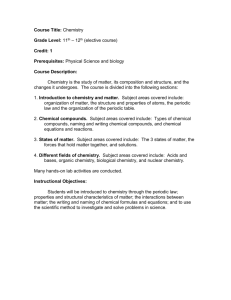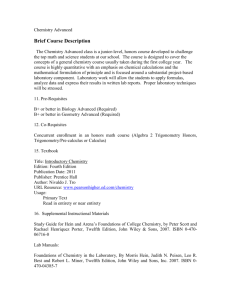Chem - Adair County Schools
advertisement

Chemistry II-AP/Duel Credit Syllabus Course Name: Chemistry II AP/Duel Credit Term: Spring 2007 Instructor: Susan Peck Pre-requisite: Chemistry I with a C average Class Text: Hein, Best, Patterson, Arena. Intro. To General, Organic and Biochemistry. Pacific Grove CA: Brooks/Cole Thomson Learning. Lab Manual: Byrd, Hendrickson and Hunter. Dubuque, IA: Experiments in General, Organic and Biochemistry. Kendall/Hunt Publishing Co. Demonstration Resources: Bilash, Groaa, Koob. A Demo a Day: A Year of Chemical Demonstrations. Heinz, Hepburn, Sconzo. Flinn Scientific Summer Workshop Manual Zumdahl. Chemistry. Heath and Co. Course Time: AP Chemistry meets daily for one 84 minute block for one semester. Course Description: In this class you will have the benefit of taking an advance general chemistry course for high school credit. Students may also obtain college credit in one of two ways: 1) take the AP Chemistry Test and obtain a three or above, 2) enroll through _______ University and obtain a 3 hr. lecture, 1 hour lab credit (for those who qualify based on ACT/GPA requirements.) The biggest differences you will find in the class is it will cover topics in more depth and move at a faster pace. You will be expected to do more work on your own and you will have to prepare longer and more in depth for exams. You will have the opportunity to do college level experiments in general and organic chemistry that would not normally be done in a high school course. Policies - Grades: In chemistry it is vital that you attend class, pay attention and take good notes, complete your daily work/problems and keep-up as chapter 5 builds on chapter 4 which builds on 3 and so on. Your grade will be figured at the following percentages: test 65%, 17% daily 18% lab reports If you qualify and enroll for credit through Western Kentucky University for college credit, the grade will be calculated as follows: Lecture Grade-3 hrs of college credit Chem. 105 (Term A and B till Christmas) or Chem 107 (Term B from January - Term C: Tests 80% and daily 20% Lab Grade -1 hr of college credit Chem. 106(fall semester) or 108 (spring) 50% test, 50% lab reports, (lab quiz average count as a lab report) To get AP credit, you must score a 3 or above on the AP test given in May. - Labs Labs will be performed each Wednesday. You will be completing college level labs and using chemicals that would not be found in a regular high school chemistry class. There will be a quiz before each lab to ensure that you have read the lab. A lab report will be turned in for each student following the lab exercise. The graded labs should be kept in a laboratory notebook. - Homework: It is due each time we take a test Homework is used to prepare you for the test and will be given well in advance so you can plan around your other activities. - Notebooks: Notebooks will be taken at the end of each Term. Your notebook should have all notes and daily work. I grade each day of notes/activity/ being dated and being complete. It will only be included on the ACHS grade not WKU grade. - Sem. Test: Semester test will be given sometime during the last week of the semester. All students will take the semester test. The test will be comprehensive. Chem. II AP/ Duel Credit Sequence of Study Lecture Term A Unit 1 Matter (12 day Unit) Ch 2 Standards of Measurement Significant digit calculations, factor-label problem solving method, metric system Ch 3 Classification of Matter States of matter, chemical formulas, mixtures/compounds Ch 4 Properties of Matter Substance properties, physical/chemical change, heat: quantitative measurement Unit 2 Atom (12 day Unit) Ch 5 Early Atomic Theory and Structure History of Chemistry, composition of compounds, atomic structure, Ch 6 Nomenclature of Inorganics Naming ionic and covalent compounds Unit 3: Compounds and Equations (12 day Unit) Ch 7 Quantitative Composition of Compounds Mole, molar mass, percent composition empirical/molecular formula: concepts and calculations Ch 8 Chemical equations Writing and balancing equations, types of chemical reactions, heat in chemical reactions Test 4: Equations and Gasses (12 Day Unit) Ch 9 Calculations of Chemical Equations Stoichiometry, limiting reactant and yield calculations Ch 12 Gaseous State of Matter KMT, gas law concepts/calculations, gas Stoichiometry calculations Ch Test 5: Atoms and Bonding (14 day unit) Ch 10 Modern Atomic Theory/Periodic table History of modern atomic history, electromagnetic radiation, the Bohr atom, electron cloud model, Ch 11 Chemical Bonds Electronic Structure, Periodic Trends, Lewis Structures, ionic/covalent bonding, molecular shapes Term B Unit 6: Water and Solutions (12 Day Unit) Ch 13 Water and Properties of Liquids Vapor Pressure, surface tension, boiling point, properties of water, hydrates Ch 14 Solutions Properties of solutions, solubility, solutions concentrations calculations, osmosis Unit 7: Acids/Bases and Equilibrium (14 day unit) Ch 15 Acids, Bases, Salts Properties, reactions, ionization, neutralization of acid and bases Ch 16 Chemical Equilibrium Le Chatelier’s Principle, equilibrium/ionization/solubility constants, reaction rates Ch 6 Thermodynamics (Zumdahl’s Chemistry Reference Book) Ch 17 Oxidation-Reduction Oxidation number, balancing oxidation-reduction equations, Voltaic Cells AP Chemistry II Laboratory Exercises Term A Fall Semester WKU Lab 1 & 2-Measurement and Determining Density The purpose of this lab: 1) teach students measurements, their accuracy, precision and uncertainty and how each of these can be stated, 2) Learn various techniques for measuring solids and liquids in the laboratory, 3) Determine the density of an unknown object Lab 3 Identification of Unknown Liquid 1) identify an unknown liquid by comparing its physical properties with those of known liquids 2) learn to use a volumetric pipet, measure density, boiling temperature, judge solubility. Lab 7 Determining the Formula of a Hydrate 1) classify compounds as hydrates 2) determine the percent water in a hydrate as well as its formula by measuring the mass of water driven from a hydrate sample. Lab 6 Distillation 1) ferment sugar to produce ethyl alcohol, distill ethyl alcohol/water mixture and hard water mixture; Lab 8 Simple Chemical Reactions 1) observe several chemical reactions and identify the evidence of a chemical change 2) complete, balance and classify the chemical reactions observed. Term B Lab 10 Molecular Shapes 1) construct models of several chemical molecules 2) determine the shape name and bond angle of the molecules Lab 11 Activity Series of Several Metals 1) observe the chemical behavior of several “fictitious” 2) construct an activity series of the “fictitious” elements Lab 12 Preparation of Oxygen 1) prepare oxygen by decomposing hydrogen peroxide 2) synthesize different oxides and product acidic and basic anhydrides for analysis Lab 14 Combined Gas Laws 1) calculate the theoretical change in volume using the gas laws 2) Calculate the percent error between the observed and calculated volumes Equilibrium 1) use cobalt II chloride, to study the effects of equilibrium shift when various stresses are applied Spring Semester WKU (most labs take two days in the spring) Acid and Bases 1) Perform a titration and calculate the percent of acetic acid in vinegar Lab 16 Hydrocarbons 1) construct various hydrocarbon molecules. 2) determine the bond angles for the various molecules Lab 17 Properties of Hydrocarbons 1) test the physical and chemical properties of various hydrocarbons 2) identify an unknown hydrocarbon using the various properties Lab 18 Aldehydes and Ketones 1) test the solubility in water and acetone, reaction with chromic acid and reaction with Lucan reagent 2) using the various tests identify your assigned unknown Term C Lab 20 Synthesis of Aspirin 1) synthesize and purify acetylsalicylic acid (aspirin) 2) calculate the percent yield of aspirin Lab 21 Esters and Soaps 1) prepare several esters and note their characteristics 2) prepare soap and compare its properties to those of a synthetic detergent Lab 23 Detection of Fats, Proteins and Carbohydrates in Foods 1) Determine the reaction selected carbohydrates with the Molisch and Benedict Reagent, iodine test and grease spot test 2) Test Xanthroprotic, Biuret and Ninhydrin test on various proteins Lab 24 Anyalsis of Vitamin C in Foods 1) analyze several common foods for vitamin C using the drop method







